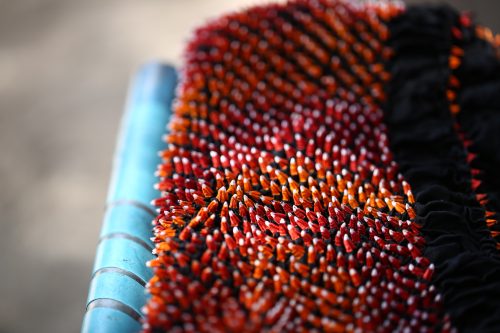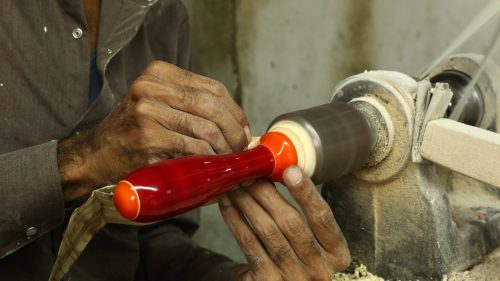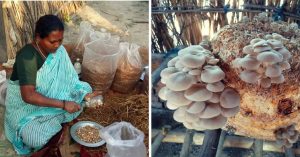TBI Blogs: Here’s How to Differentiate Between Fake & Authentic Handlooms & Handicrafts
Mechanization of processes has led to an influx of fake handlooms and handicrafts in Indian markets. Here's how to differentiate between authentic products and fakes.

Mechanization of processes has led to an influx of fake handlooms and handicrafts in Indian markets. Here’s how to differentiate between authentic products and fakes.
Every individual handcrafted product has a unique story to tell. And yet, as the product moves through the value chain, this story gets buried deeper and deeper in the layers of time till eventually, it is lost to the world. This story is most often a reflection of the craftsman who poured himself into his handicraft. It may speak of the long hours that he laboured at his potting wheel, perfecting minute details by candlelight. Or it may convey the many miles that he had to walk to transport his deftly crafted goods to the nearest market.
The story could hold a million possibilities. But by the time it reaches the customer, the artisan behind the handicraft is forgotten. And his story remains untold.

Today, fewer artisans have stories to tell. With the advent of globalisation and virtual markets, new markets have unfolded overseas. This also means that skilled artisans from around the globe have seized the opportunity to meet a growing, global demand for their work.
For Indian handicrafts, however, international competition is hardly the problem. The real concern for homegrown artisans is the threat posed by colossal manufacturers who produce handicraft replicas en masse. These industrial bigwigs have the resources to keep abreast of customer trends, respond to them swiftly and deliver their products through the right distribution channels.
The trouble is, these well-engineered replicas are marketed as original handmade pieces by these corporations. As a result, Indian artisans are losing market share, income and the niche they have worked so hard to create.

There are a number of sectors that have been straining under the pressure of the ballooning counterfeit craft industry. Varanasi, for instance, has long held a place on the world map as the cradle of Banarasi brocade.
While the Uttar Pradesh government has not released any statistics about the weaving industry or its size in Varanasi today, one report suggests that the town is home to approximately 5,00,000 weavers. The 2011 census revealed that amongst these, only 51% are currently engaged in spinning and weaving. Today, only about 10% of weavers work on handlooms; the rest have abandoned it in favour of power looms. This hasn’t been an overnight phenomenon.
This migration of workers started back in 2001, when India lifted quantitative restrictions on silk imports. This paved the way for Banaras to become a cesspool of cheap, Chinese silk yarn. Chinese silk yarn is ideal for power looms. Composed of between 18 and 20 filaments, the thread flows easily through the machinery. Indian thread, on the other hand, contains only 10 to 20 filaments, making it more difficult to work with. But while Chinese silk may match the quality of its Indian counterpart, Indian silk is far more durable. Some Banarasi saris are even made in China, and are imported and sold in shops in Banaras. Mind you, the imitations are just as beautiful, and can bedazzle any customer with their vibrant colours and vintage motifs. You would never even know that it was made in a factory. Yet, the difference lies in the detail.
Handloom saris are inspired by Mughal designs, and feature handmade patterns like amru, ambi and domak. Saris made in factories cannot match this level of detailing and do not carry these traditional Persian motifs.

The reality is that a handloom weaver in Banaras typically takes about fifteen days to complete one sari, and his earnings in a month are just south of Rs. 4,000, hardly enough to sustain an individual, let alone a family. Ironically, the government has provided free electricity to power looms, and handloom workers have been relegated to the side lines.
Since 2002, over 175 Banarasi weavers have committed suicide as a result. Today, it is more lucrative for a weaver to share weaving techniques and skills with a power loom than to continue in his own profession. By sharing know-how about traditional patterns and weaving styles, he can earn more than if he were to weave a single sari.
The obscure town of Sualkuchi in Assam is the silk centre of the state. Its beleaguered silk industry, however, is struggling to survive. The influx of Chinese silk has hurt the small community. In September 2013, after realising that they needed to protect their interests and combat spurious silk imports, the weavers of Sualkuchi formed the Sualkuchi Tant Unnayan Samiti, a committee dedicated to prohibiting unscrupulous traders. But perhaps the efforts of the denizens of Sualkuchi were too little, too late.
In 2007, the Association of Handloom Units released a report that announced that 60,000 Bodo households would lose income as a result of counterfeit products. The economic decline in the silk town has continued ever since.
The toy town of Channapatna, in Karnataka, has been similarly challenged by the invasion of China-made wooden toys in the country. In December 2015, the Lok Sabha acknowledged the harm done to the Indian toy industry as a result of Chinese imports. Toy imports increased at a compound annual rate of 25% between 2001 and 2012, a solemn indicator of how harshly local craftsmanship has been overthrown by Chinese automation.
Although the central and state governments have taken steps to alleviate the downslide, they have not been very effective. The Karnataka government has allotted subsidised power and 254 houses to toymakers in the town. Yet, there are droves of workers who are still left unsupported.
There are only around 1,000 artisans in Channapatna now, and the numbers are dwindling. Children of craftsmen are seeking livelihoods in other industries, and the Channapatna toy engine is slowing down.

In May 2016, the Enforcement Wing of Quality Control Division, Directorate of Handicrafts directed raids in handicraft shops in Srinagar to validate the authenticity of their products. Handicraft stores in the valley have earned a notorious reputation for cheating tourists by selling them imitation versions of original handicrafts. Kashmiri Pashminas, in particular are adroitly replicated by power looms and are regularly passed off as originals at lower prices. Weavers in Srinagar and adjoining areas are witnessing a decline in the Pashmina shawl industry and, in the last twenty years, 90% of the women spinners have left the industry because manufacturers and customers have resorted to cheaper alternatives.
Perhaps this collective undermining of artisanal skillsets is deep-rooted in something else. Urban perceptions towards handicrafts, for instance, are definitely worth examining. Market trends and preferences often shift based on conscious marketing strategies employed by brands. Large companies build brand consciousness through an array of promotional and advertising tools. Cottage industries, unfortunately, do not have the reach or the capital to employ these techniques, and get left behind in the mind of the customer. Some even consider handcrafted items too traditional, archaic even.
Despite the effort and time entailed in crafting a single product, customers expect a low price. Cue, counterfeit products. Positioning handicrafts as novel, aspirational products, requires serious investment and effort. And it is the need of the hour.

The tragedy is that even the greatest aficionados of handlooms and handicrafts are seldom able to differentiate between genuine handmade products and factory-made replicas.
Take handloom for instance. There are few ways to distinguish between authentic silk and synthetic polyester fabric. One way is by burning a single fibre from the cloth. If the thread leaves a plastic-like residue behind, you know you have a saree made of polyester. But a thread that vanishes entirely, without a trace, is testimony of pure silk or cotton fabric.
There are aesthetic differences too. If you look carefully, you’ll notice that handloom weaves, though meticulous, are not always even. In fact, that is one of the classic features of handloom; the diminutive difference between each thread.
Also, when it comes to pure silk, handloom designs can get tremendously intricate. Artisans work arduously to weave minute details in their tapestries, a feat that machinery cannot parallel.

The government has taken certain measures to distinguish genuine products from spurious ones. Tags certifying authenticity have been assigned, based on industry. Handloom mark, Woolmark, Silkmark, Seal of Cotton and Craftmark correspond to the handloom, wool, silk, cotton and handicraft industries respectively. It is up to the customer to inspect a product closely to determine its origin. A good practice is to buy from organisations who follow Fair Trade Norms.
Artisans remain one of the lowest socio-economic classes in India today, and the community is shrinking rapidly. The onus lies on policy makers to strengthen the value chain, drive marketing programmes and empower artisans. Only then, will artisanal products earn the recognition that they deserve. In turn, the community of craftsmen in the country will flourish, and maybe someday soon, more artisans will have stories to tell.
Incase you know of any artisans who India Kala can work with, please mail us their details at [email protected].
Like this story? Or have something to share? Write to us: [email protected], or connect with us onFacebook and Twitter.
NEW: Click here to get positive news on Whatsapp!
This story made me
- 97
- 121
- 89
- 167
Tell Us More
We bring stories straight from the heart of India, to inspire millions and create a wave of impact. Our positive movement is growing bigger everyday, and we would love for you to join it.
Please contribute whatever you can, every little penny helps our team in bringing you more stories that support dreams and spread hope.



















